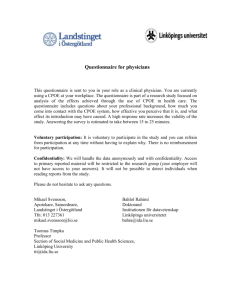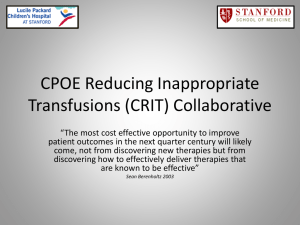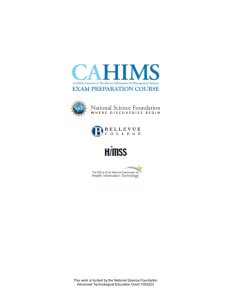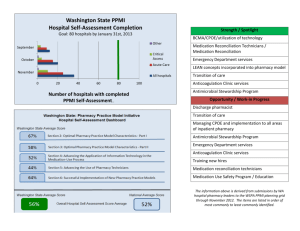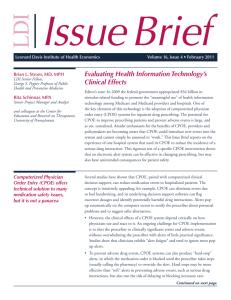comp15_unit10a_audio_transcript
advertisement
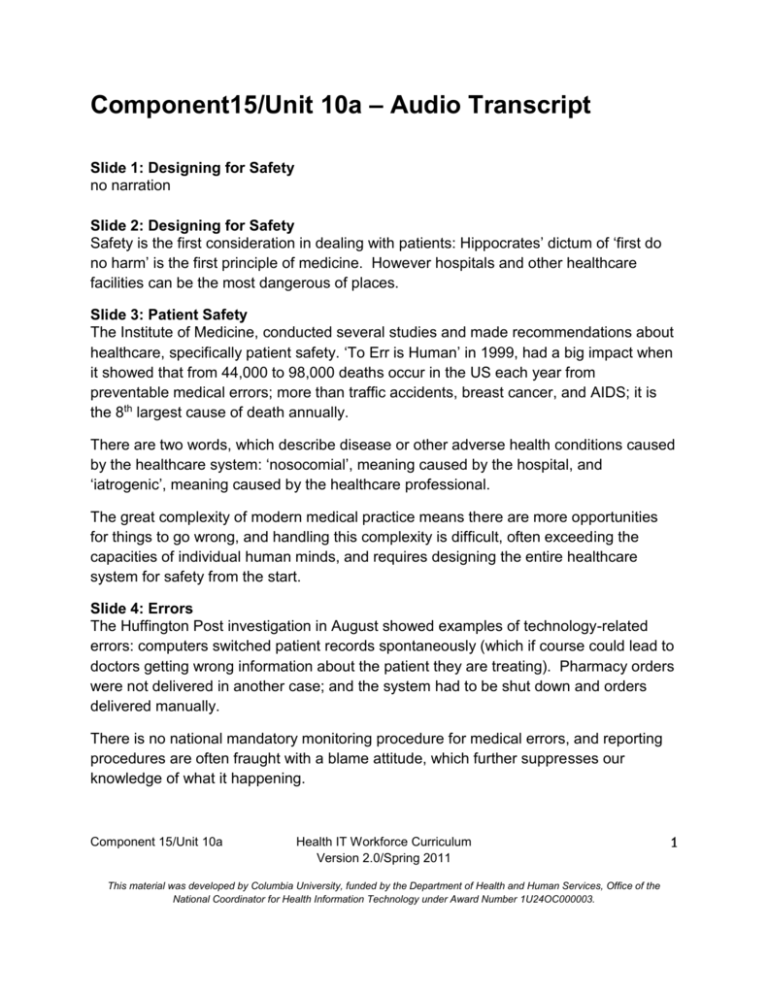
Component15/Unit 10a – Audio Transcript Slide 1: Designing for Safety no narration Slide 2: Designing for Safety Safety is the first consideration in dealing with patients: Hippocrates’ dictum of ‘first do no harm’ is the first principle of medicine. However hospitals and other healthcare facilities can be the most dangerous of places. Slide 3: Patient Safety The Institute of Medicine, conducted several studies and made recommendations about healthcare, specifically patient safety. ‘To Err is Human’ in 1999, had a big impact when it showed that from 44,000 to 98,000 deaths occur in the US each year from preventable medical errors; more than traffic accidents, breast cancer, and AIDS; it is the 8th largest cause of death annually. There are two words, which describe disease or other adverse health conditions caused by the healthcare system: ‘nosocomial’, meaning caused by the hospital, and ‘iatrogenic’, meaning caused by the healthcare professional. The great complexity of modern medical practice means there are more opportunities for things to go wrong, and handling this complexity is difficult, often exceeding the capacities of individual human minds, and requires designing the entire healthcare system for safety from the start. Slide 4: Errors The Huffington Post investigation in August showed examples of technology-related errors: computers switched patient records spontaneously (which if course could lead to doctors getting wrong information about the patient they are treating). Pharmacy orders were not delivered in another case; and the system had to be shut down and orders delivered manually. There is no national mandatory monitoring procedure for medical errors, and reporting procedures are often fraught with a blame attitude, which further suppresses our knowledge of what it happening. Component 15/Unit 10a Health IT Workforce Curriculum Version 2.0/Spring 2011 This material was developed by Columbia University, funded by the Department of Health and Human Services, Office of the National Coordinator for Health Information Technology under Award Number 1U24OC000003. 1 Food and Drugs Administration (FDA) official Jeffrey Shuren, who receives reports, tied 6 deaths and more than 200 injuries to EHRs. This does not necessarily mean the EHR caused the error, but that somewhere in the system conditions occurred that allowed an error to happen. Slide 5: Pediatrics: Increased Mortality with Computerized Physicians Order Entry (CPOE) A highly influential paper about unexpected increased mortality in a pediatric emergency setting found that mortality significantly increased after a Computerized Physicians Order Entry (CPOE) implementation. It is instructive to examine the reasons why. Slide 6: Increased Mortality: Reasons A particular hospital implemented CPOE and clinical applications over the whole hospital in 6 days. This did not give people enough time to notice problems, adjust to the new workflow imposed, and anticipate errors. Workflow almost always changes when clinical systems are installed, and the effects (anticipated and unanticipated) of these workflow changes must be analyzed for possible adverse consequences. Usually this must be done when all the staff involved can give feedback and the system is in situ. This cannot be done even for a single ward in 6 days. A major problem is that order entry was not allowed until the patient was physically present and entered into the system, meaning that treatments could not be given promptly when needed. Another problem is that medications were now all located in the pharmacy, making them not conveniently available e.g. in Intensive Care Units when needed. This change alone, even without CPOE implementation, would have had serious consequences. Small ‘tests of change’ on a single unit would be better done beforehand to test the effects and efficiency of such changes. Another problem is that the system required that nurses activate drugs orders, meaning they had to spend more time at computers, away from the patient, and less time at the bedside where they could observe changes in the patient’s condition Similarly, order entry by doctors and activation by nurses were often at terminals separated by several beds or ICU pods, opportunities for face to face communication between doctors and nurses was diminished. Component 15/Unit 10a Health IT Workforce Curriculum Version 2.0/Spring 2011 This material was developed by Columbia University, funded by the Department of Health and Human Services, Office of the National Coordinator for Health Information Technology under Award Number 1U24OC000003. 2 Slide 7: Increased Mortality Reasons: (cont.) A further problem was that it changed bedside care organization. Before, clinicians would converge at the bed to stabilize the patient. After CPOE implementation, one doctor had to stay at the computer to enter orders into the system in the first hour after the patient was admitted if the patient was in extremis. Finally, slowness of the computer system, due to both bandwidth issues and the design of the interface, could have had an effect. We see that anticipating and planning for potential problems in the design and implementation of CPOE is of utmost importance. Other things that can be learned from this study are the importance of assessing overall mortality rates before and after, and not just adverse drug events (which actually went down according to that hospital’s reports). CPOE efficacy is often measured in terms of ADEs, so it is important to consider the larger picture of patient outcomes. Slide 8: Horsky: Dosing Errors (Detailed Analysis) Jan Horksy conducted a detailed study of a dosing error, and found that it was the result of faults in the interaction between human and computers; and that usual methods of analysis from different fields would not have identified them. This included confusing laboratory results review screens, usability problems, problems with user training, and inadequate safeguards in the system. Slide 9: Errors, Safety, Perfectibility: Errors Viewed in 2 Ways It is important to realize that errors can and have been viewed in two ways. One approach focuses on the individual person and tends to assign blame, in the belief that if clinicians are well trained, work hard enough, errors can be avoided and ‘perfection’ result. The increased complexity in health care has been met with the belief that increasingly sophisticated and lengthy training will solve the problem. The system approach, on the other hand, examines multiple contributions to error, not just from individuals but the entire work environment. It recognizes that perfection will not happen, but tries to anticipate and avoid errors, and build a resilient system which can detect and recover from potential errors rapidly. This view has been prevalent in aviation ever since the 1930s, when a new plane with four engines and a highly experienced pilot crashed. Recognizing that no one had more experience than that pilot, analysts focused on the system changes, which led to the accident. Component 15/Unit 10a Health IT Workforce Curriculum Version 2.0/Spring 2011 This material was developed by Columbia University, funded by the Department of Health and Human Services, Office of the National Coordinator for Health Information Technology under Award Number 1U24OC000003. 3 Slide 10: Human Factors (Elrod, 2009) There are several resources and recognized areas in which errors and human factors are being studied. Joint Commission Accreditation Hospital Organizations (JCAHO) has formulated national patient safety goals, including medication safety. Designers of CPOE systems have devised ways to distinguish drugs in pick lists that otherwise look and sound alike. Decision support systems are especially focused on notifying the clinician in case of a conflict of an ordered drug with other drugs or with allergies. Slide 11: Design Considerations (Kaye, 2010) Approach to design should include building error tolerance into the system, redundancy, and prevention of critical actions after minor errors by the user. This sort of approach is seen in our everyday computing, for example, a screen will ask ‘Are you sure you want to delete this file?’, to ensure that a simple slip of the mouse does not create major difficulties. One wants to make the correct actions easier, and incorrect or critical actions difficult. Having parameter limits on some fields (such as limits on a blood pressure entry) can help prevent errors. Slide 12: “Use Safety” Evaluation (Kaye, 2010) Methods of designing a safe system include incorporating typical users early in the process, doing formative evaluations using realistic test scenarios, if possible. Specific and meaningful performance measures must be used, so that effectiveness of the system can be continuously evaluated, compared with the effectiveness of the same procedures before implementation, and with subsequent developments. Slide 13: Retrospective Incident Analysis Retrospective incident analysis is a system of analysis designed to identify factors leading to failure. However now it is also used to analyze the conditions under which error recovery can take place, and identify near misses. Near misses themselves can be used to identify recovery factors; for example, what makes an incident a near miss rather than a full error could be intervention by a clinician, or the system having been designed to prevent a particular type of error, and other factors. Slide 14: Order Sets Order sets are a common feature of Clinical information systems. They can speed up ordering and help incorporate evidence based medicine, but they can also spread outdated medicine if not properly implemented in an organized way with standards and supervision. Component 15/Unit 10a Health IT Workforce Curriculum Version 2.0/Spring 2011 This material was developed by Columbia University, funded by the Department of Health and Human Services, Office of the National Coordinator for Health Information Technology under Award Number 1U24OC000003. 4 Slide 15: Controversies Surrounding Order Sets Some of the design features of order sets include linking drugs, which must be given in a certain time sequence after certain time intervals, so that if one changes, the others do too. This kind of thoughtful programming to anticipate changes is important in preventing adverse events. Slide 16: Patient Controlled Analgesia Likewise, linked orders should discontinue drugs (prompt the clinician to discontinue them) when this is appropriate, such as when a primary order is cancelled. Patient controlled analgesia (PCA) orders often include other orders for monitoring the patient, rescue medications, side effect medications, and so on. Discontinuing the PCA order should prompt the user to also discontinue the other associated orders, and make it easy to do so. Slide 17: Examples of CPOE Design Features However there may be times when linked orders must be mutually exclusive (such as in high-risk drug orders). There may be multiple possible choices, but alternates should be excluded (such as being greyed out and impossible to select) after the choice is made. In this way overdoses of drugs with similar actions could be prevented. Presenting only those options appropriate for the patient (such as only those drugs to which the patient is not allergic, or only those drugs appropriate for that person’s sex) is another design feature. CPOE should incorporate standards based on the literature, local consensus, institution-specific drug formularies, and similar protocols for common care elements such as surgical antimicrobial prophylaxis, DVT prophylaxis, blood sugar management and postoperative nausea. Standards incorporated into the EHR can assist in ensuring proper protocols are followed. Slide 18: No Default Selections This screenshot shows that no defaults are selected when the screen is first shown. An example of risk of errors due to inappropriate selection is lowered. Slide 19: Other Design Requirements Other design features include consistent naming conventions that facilitate finding desired items (such as drug names in pick lists, unit names, patient names, and so on). Preselected orders are all right for some nursing and lab orders where the same treatment is prescribed for virtually all patients. For describing order sets in lists, it has Component 15/Unit 10a Health IT Workforce Curriculum Version 2.0/Spring 2011 This material was developed by Columbia University, funded by the Department of Health and Human Services, Office of the National Coordinator for Health Information Technology under Award Number 1U24OC000003. 5 been found helpful to state the names as set name, service name, then procedure name. Slide 20: Order Set Safety Order set safety also depends on having appropriate review committees, which ideally are multidisciplinary, and set up prior to CPOE go live. These committees need to discuss any necessary or planned changes to procedures, standardization, items which may not be suitable to electronic formats, and so on. Authors of order sets can explain their intent to the committee. Misinterpretations concerning orders can at best lead to extra work; at worse they can result in harm to patients. Slide 21: Review and Supervision Review by committees should take place after deployment, to determine when sets should be removed. They should have input from established committees, such as those for pharmacy and therapeutics, critical care, and also others. The rapid advance of clinical knowledge also poses problems since it requires that the order sets keep up, and someone must be in charge of this, with an overall strategy. Slide 22: Unintended Consequences of CPOE (Campbell et. al., 2006) Any new changes in a hospital system, CPOE can have unintended consequences, which can be benign or adverse. The common ones include more or new work for clinicians, unfavorable workflow issues, increased demands by the system, and problems related to the persistence of paper, or the inadequate use of paper. Introduction of CPOE can result in harmful changes in communication patterns and practices, as we saw with the pediatric emergency care example described earlier. CPOE introduction can also change power relationships, and the loss of control over work can result in negative emotions among staff. New kinds of errors, for which there may not be workarounds, can be another consequence. Finally, staff and/or the entire system may grow to be over dependent on technology, so that adverse results ensue when there is downtime or other problems. There have been instances when the clinical information system went down and clinical information was suddenly unavailable through other means, such as paper. Clinical decision support can cause overdependence on knowledge sources available through it, and some claim that clinical systems can adversely affect teaching, since student clinicians may no longer have the experience of repeatedly entering common orders and becoming familiar with them. Component 15/Unit 10a Health IT Workforce Curriculum Version 2.0/Spring 2011 This material was developed by Columbia University, funded by the Department of Health and Human Services, Office of the National Coordinator for Health Information Technology under Award Number 1U24OC000003. 6 Slide 23: Checklists - Gawande A recent book the ‘Checklist Manifesto’ by Harvard surgeon Atul Gawande, describes one very effective intervention, which has had high impact in medicine. Modern medicine is extremely complex, changes rapidly, and has developed far with accomplishments unheard of in previous decades. Gawande gives the example of a girl drowned under ice with multiple medical problems who was brought back to life by the hundreds of extensive procedures available with modern medicine. The medical system’s response to increased complexity has been for clinicians to specialize and undergo ever-lengthier sophisticated training. These procedures have dependencies; keeping track of all the steps can be beyond even expert’s memory. For this reason, checklists can be a solution. Another example is modern buildings. Building a skyscraper or ordinary office complex is an example of a set of extensive complex procedures with dependencies, and checklists (often implemented in software) are used to coordinate the work. Slide 24: Checklists - Gawande (cont.) Gawande instituted operating room checklists after studying their use in aviation. He found there was resistance among clinicians due to their self-perception as highly trained experts who should not need checklists. However 80% of surgeons agreed they were valuable after using them, while 20% were still resistant. When asked if they would want checklists to be used, when being operated on, 93% said yes. Slide 25: Pronovost Peter Pronovost, the originator of the recent emphasis on checklists, also had to change team communication. Aside from the checklist itself, part of his innovation was that nurses could correct doctors if they did not follow a simple 5-item checklist for central line infection prevention. This entails dealing with the highly hierarchical structure of medical environments. However the administration was behind the change, so nurses were supported. Slide 26: Pronovost (cont.) The combination of checklist use and correction by nurses led to dramatic reductions in infections, which dropped from 2.7/1000 patients to 0 in three months. When the system was deployed statewide in Michigan, it is estimated to have saved 1500 lives in the first year, decreasing infections 66%. Slide 27: Pronovost - UIC Unintended consequences of CPOE can be good (such as when CPOE implementation leads us to identify unnecessary procedures) or fatal (as we see in the example of the Component 15/Unit 10a Health IT Workforce Curriculum Version 2.0/Spring 2011 This material was developed by Columbia University, funded by the Department of Health and Human Services, Office of the National Coordinator for Health Information Technology under Award Number 1U24OC000003. 7 pediatric unit). While it is impossible to predict every consequence, thoughtful consideration of probable effects, inclusion of all staff who are affected and their input into the decision-making process, and implementation which has procedures in place for feedback with time for correction, are important in planning. Slide 28: Shabot - Ten Commandments for CIS Good adoption of clinical information systems involves using certain principles, listed on this slide. Slide 29: Additional Reference: Top 10 Sentinel Events (reviewed by JCAHO 2008) by type no narration Component 15/Unit 10a Health IT Workforce Curriculum Version 2.0/Spring 2011 This material was developed by Columbia University, funded by the Department of Health and Human Services, Office of the National Coordinator for Health Information Technology under Award Number 1U24OC000003. 8


